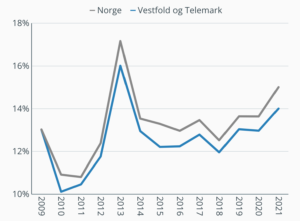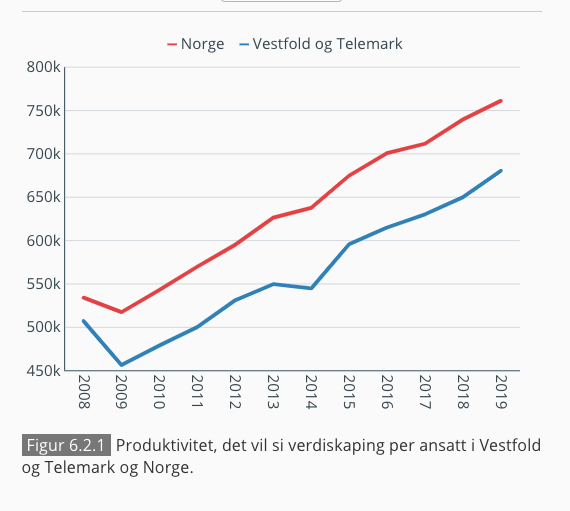The business structure in Telemark is reflected in its historical development. It has been characterised by its raw material-based process industry and other primary industries. With Grenland at the forefront, we have over 100 years of experience in industry, development and innovation. New industry, both industrial and those with a high degree of innovation are growing and contributing to a modern business structure throughout the county. Grenland is today Norway’s largest industrial area and center for the petrochemical industry.
Number of employees: 182.482
Source: Statistics Norway, August 2022.
In Vestfold and Telemark, almost 10% of those employed are in industrial work.
Source: Mitt og ditt Vestfold og Telemark.
Unemployment: 2,1%
Source: Statistics Norway, August 2022.
Establishment frequency in Vestfold and Telemark and Norway:

Establishment frequency is the number of companies that are newly registered per year as a percentage of the number of already existing companies from the beginning of that year. The establishment frequency indicates whether there are greater or fewer new establishments in relation to the number of existing companies.
We can see how establishment frequency has been developing since 2009 in Vestfold and Telemark and Norway in the figure. The establishment frequency in Norway was artificially high in 2013 due to technical registration conditions in the unit register. In recent years, the establishment frequency has been between 12 and 15 percent.
Source: Knut Vareide, Telemark Research (2021)
Productivity in business:

The figure shows the development in productivity in the business sector in Vestfold and Telemark and Norway from 2008 to 2019. Four industries have been excluded from the calculations. They are, oil extraction, finance, agriculture and foreign shipping.
In 2019, values were created for 680,555NOK per employee in the business community in Vestfold and Telemark.
Productivity in the region is increasing and Porsgrunn is one of the municipalities with the highest productivity in the last decade.
The process industry is more productive in Vestfold and Telemark than elsewhere in the country.
Source: Knut Vareide, Telemark Research (2019)
Vestfold and Telemark have high greenhouse gas emissions, mostly from industry and road traffic, which account for 70% and 13% of the emissions, respectively.
Total greenhouse gas emissions in Vestfold and Telemark decreased by 0.55% from 2018 to 2019 to 4.4 million tonnes of CO2 equivalents. The industry accounted for 69% of the total emissions in Vestfold and Telemark in 2019.
Vestfold and Telemark county municipalities have set a goal of reducing greenhouse gas emissions by 60% by 2030.
The average decrease in greenhouse gas emissions from 2009–2018 was 22,000 tonnes of CO2 equivalents per year. To achieve the county’s goal of a 60% emission reduction by 2030, emissions must be reduced by 212,000 tonnes per year. This requires an adjustment to a society where increased value creation goes hand in hand with higher resource productivity and lower greenhouse gas emissions.
In September 2020, the government recommended launching Norways project for capture and storage of CO2 (CCS). This project has been named Langskip, and involves, among other things, funds for a carbon capture plant at Norcem in Brevik. This puts the region in a unique position to solve national and global climate challenges through climate technology.
Source: Mitt og ditt Vestfold og Telemark